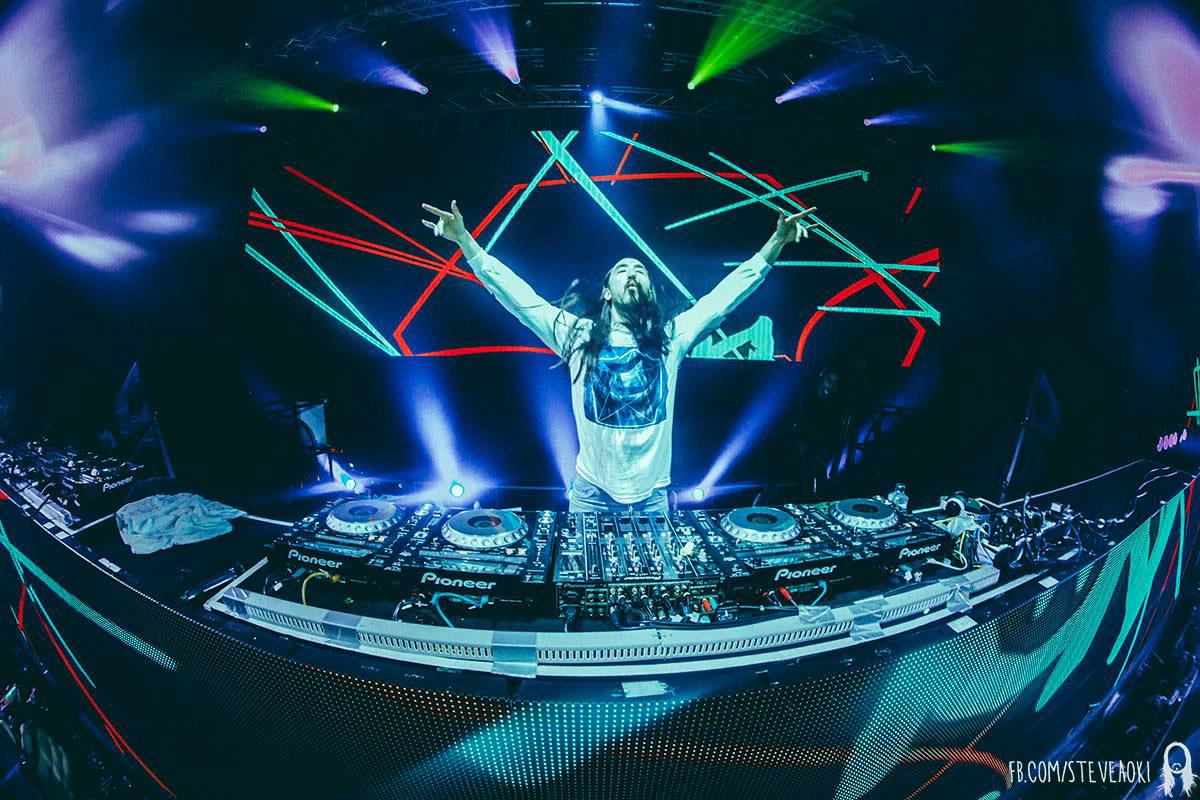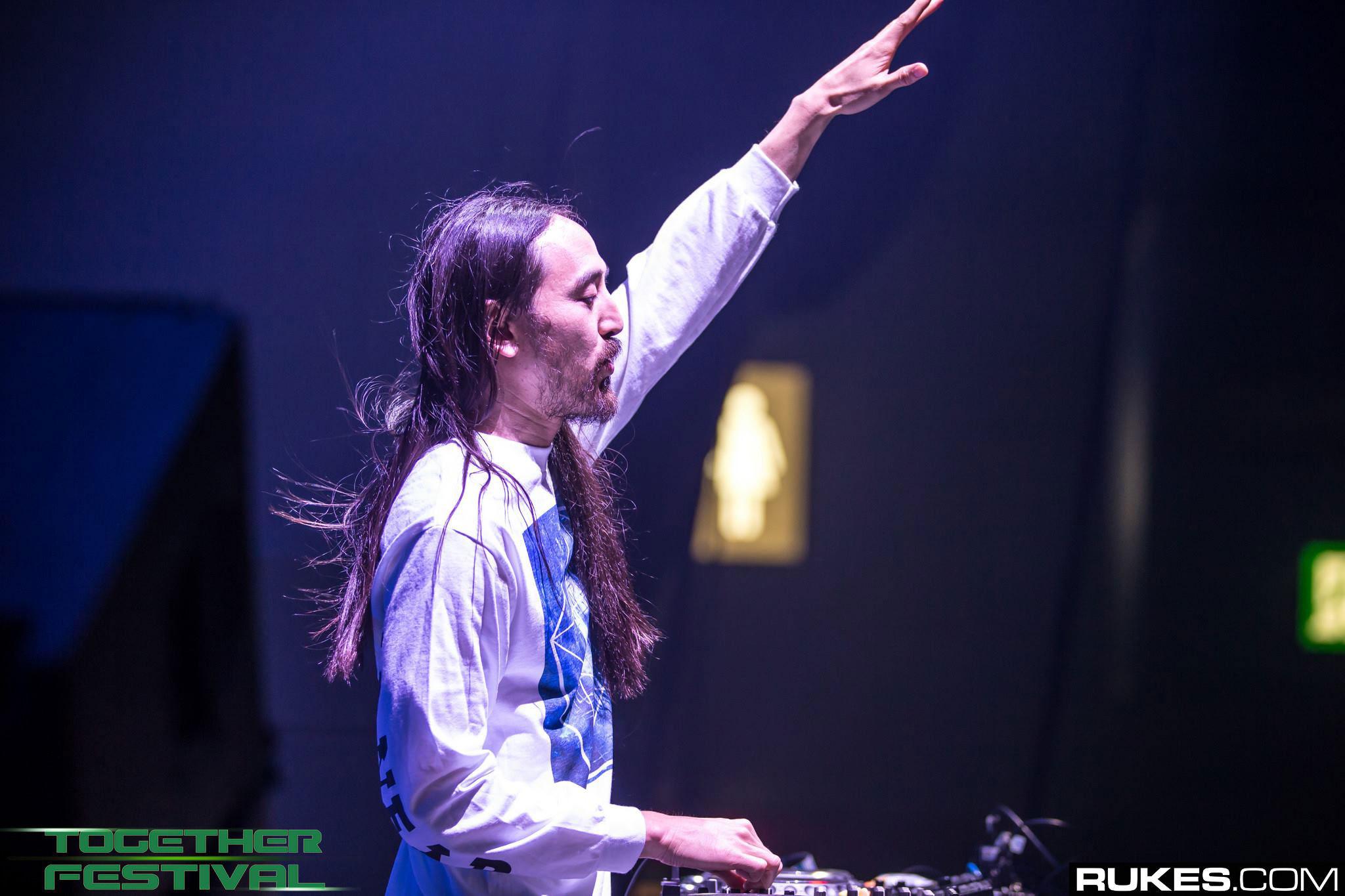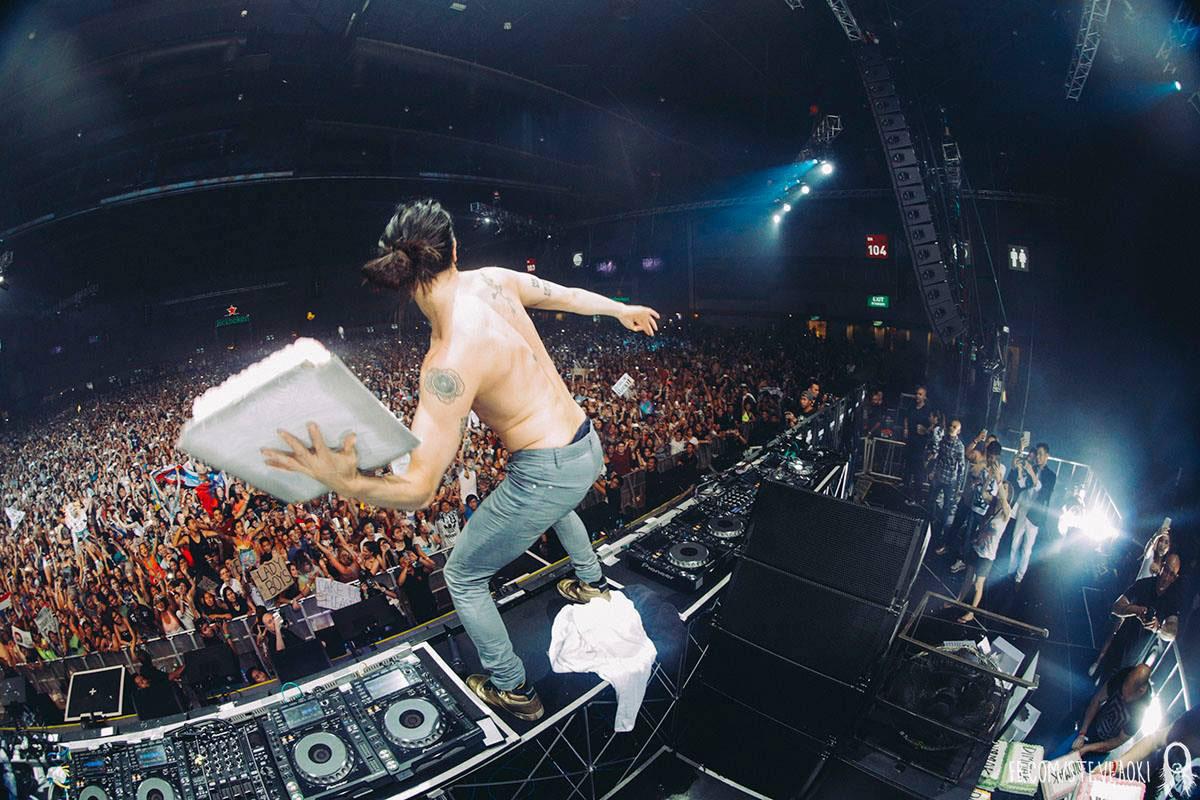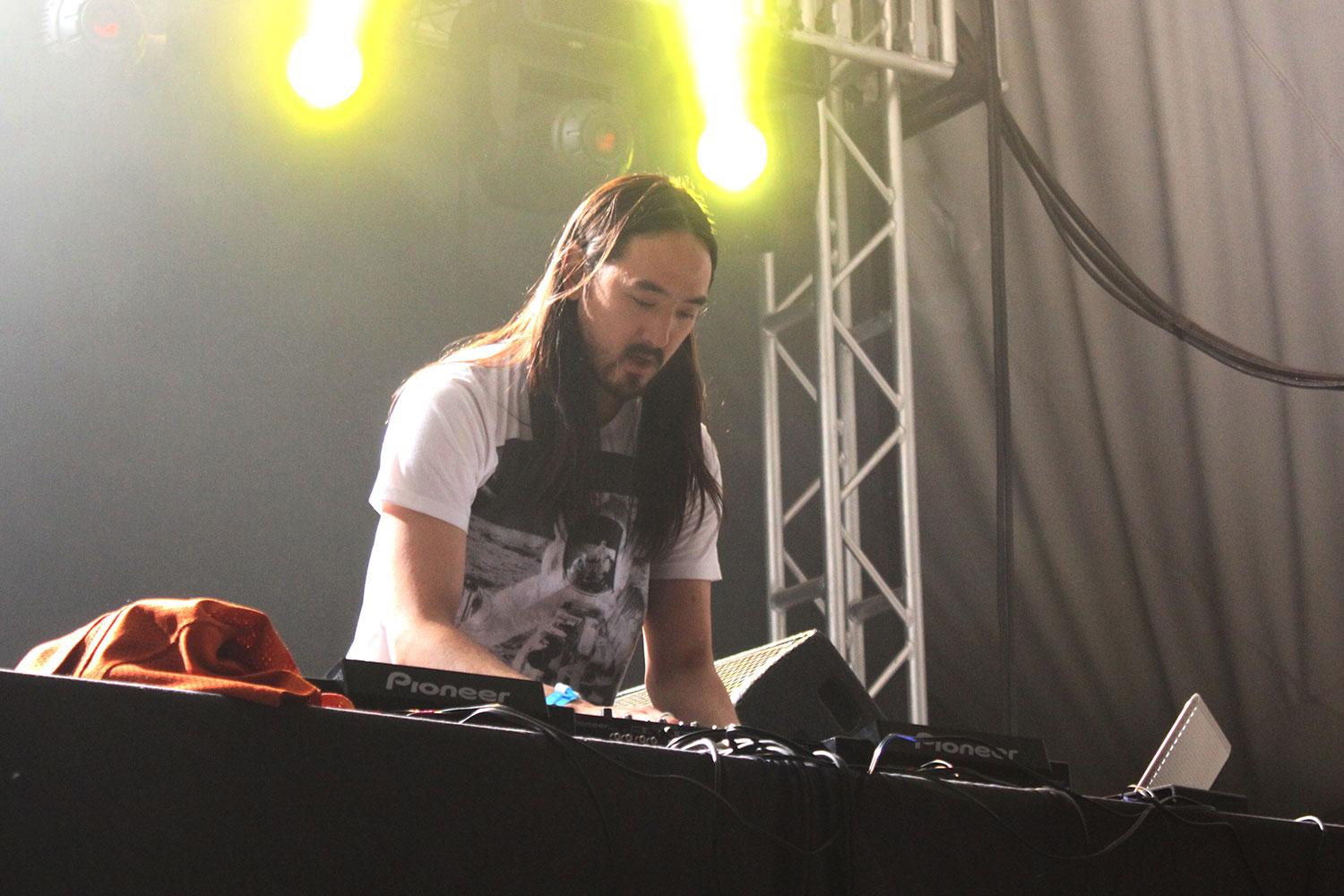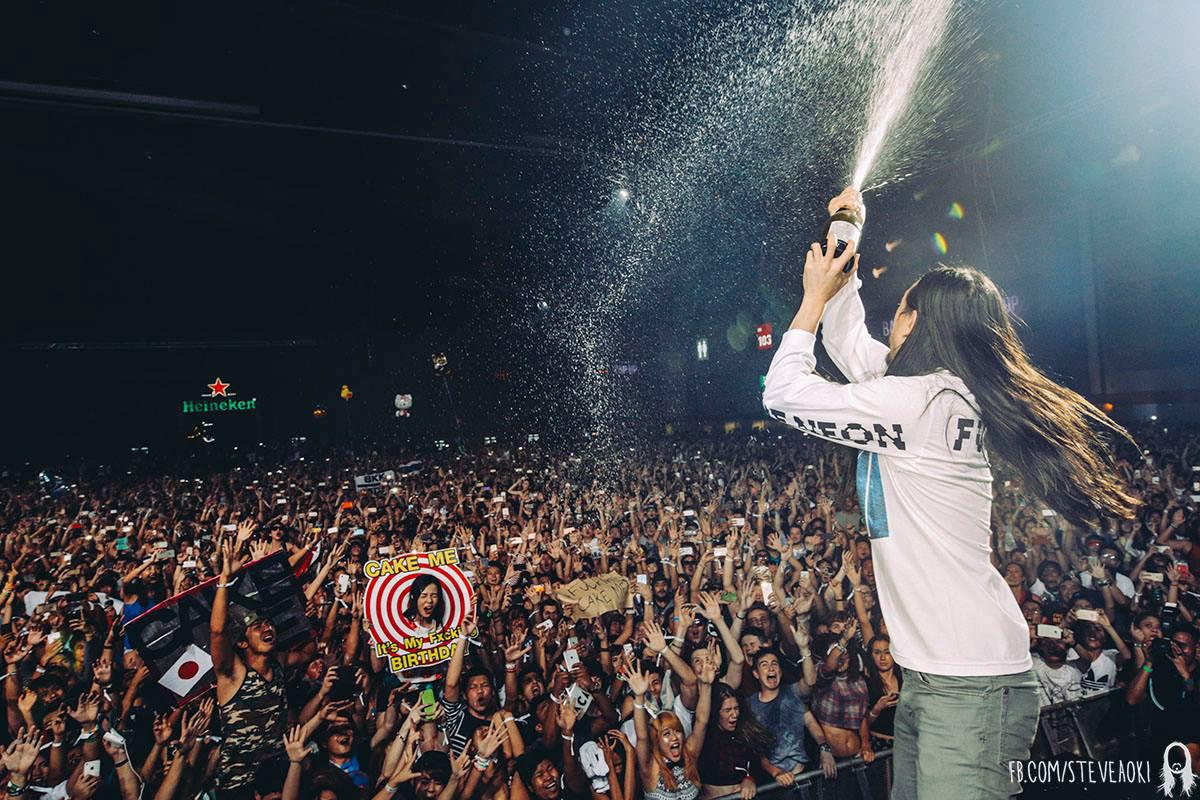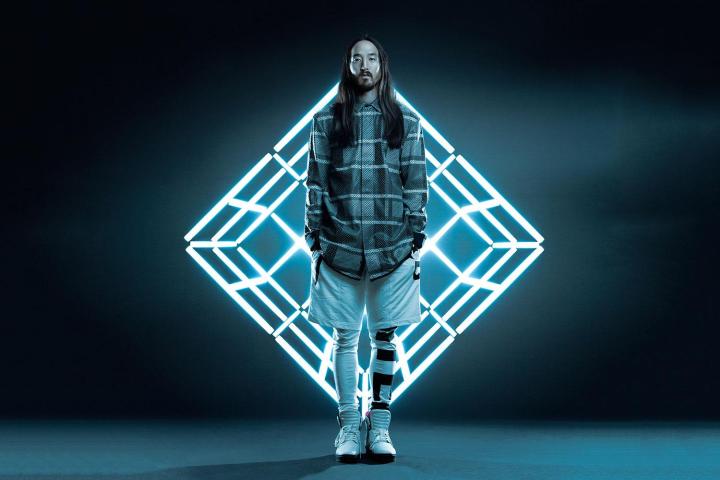
“Eventually, music will all be in our brains. It will be a full immersion.”
Less than 48 hours removed from headlining LAoki, an outdoor concert he co-hosted with Mayor Eric Garcetti in downtown Los Angeles, superstar DJ Steve Aoki is already in New York, contemplating putting on a similar event in Manhattan.
“I’d love to do something like that out here,” he says. “I always consider New York my second home. It built me, and it raised me as an artist. Growing up, I always came here. My dad [the late restaurateur Rocky Aoki] was here — New York was his stomping grounds — and I always thought of it as a place I had to be.”
Aoki rarely sits still. He can be found DJing hundreds of sets across the globe every year — some featuring his infamous cake-throwing, some not. He also likes to toss genres together when it comes to his music, as evidenced by the wide swath of collaborative, melodic-driven tracks that comprise Neon Future II (Dim Mak/Ultra Music), released last week on various platforms. Future II is the skyward-reaching bookend to 2014’s Neon Future I, which boasts cuts like the hard-thumping hit Delirious (Boneless), featuring Kid Ink. “There are a lot more party songs on Future I. It’s a fun-spirited album,” Aoki admits. “Neon Future I is more about science and technology, what kind of science fiction is happening here in our time on earth — life expansion, and life extension. Future II is darker and more emotional, and there’s more context. It’s a different piece.”
After sliding two veggie sausages off a plate into his avocado scramble — the man is always mixing something new — Aoki told Digital Trends about how his drops are different live than on record, his view of high-resolution audio, and his wish to perform the first live set on Mars.

Digital Trends: Do you feel like you have different mindsets when you play in New York as opposed to Los Angeles?
Steve Aoki: When I do a big show here in New York, I definitely think “Upper East Coast.” That’s why we want to be near Manhattan when we play festivals here, to represent this whole area. When you think of LA, it’s the same thing. It’s Southern California, and California is a huge demographic for dance music.
As far as the overall vibe — the vibe is very similar. A lot of energy, and a lot of education — people really know the music. They don’t just know the biggest hits; they know all the songs.
I like how Future II tracks like Heaven on Earth make it into your set. It gives me a deeper appreciation of what I’m getting.
That song in particular, when we played it out in LA, we brought out the singer [Sherry St. Germain] — and I really felt that took the show to a much deeper level, like you were talking about. It really sunk into me. I felt something I hadn’t even felt in my own self when I first heard that song. I produced that song over 2 years ago. It was done and dusted over 2 years ago.
Do you have a different plan for each of your collaborators, in terms of how you put the mixes together? Do they say, “Hey, I want my vocal effects to be like this,” or is that something you suggest?
It’s case by case, but generally, for each artist, I’ll produce four different records that I assume would fit as the bridge that would meet us both ways. Whatever song they choose that suits them, then we can start working on it, and the other three may become working ideas for other artists.
“I like to write a lot of my ideas when I’m in my own space, because I have the time.”
A melodic break is generally where I start. The drop — I don’t really think about the drop with the artist; I think more about how they sound over a melodic break. But in some cases, I’ll show a lot of music to someone to be efficient with time. Sometimes, none of them work, and we may leave it at that. But if I really want to work with an artist, like Machine Gun Kelly — I wrote five different tracks for him. I thought his energy would fit one of them, but it didn’t. I went back in the studio two or three times, to the point where we just started from scratch. I started with a beat, and then he was vibing in the booth, and then I came up with another idea around his vocal, and we kind of just jammed it out. [Machine Gun Kelly appears on Neon Future I’s Free the Madness.]
The majority of Wonderland (2012) was like that too — just jamming with the artists, because I had more time back then. Also, that album took me four years. Even though this was a two-year process, a lot of my time is eaten up on the road. I like to write a lot of my ideas when I’m in my own space, because I have the time.
What gear are you working with at this point, or does it fluctuate?
I finished everything for Neon Future I in Ableton, and some of II is Ableton. For Neon Future II, I started migrating towards Logic [Pro]. I just think it’s a better system to produce off of. There are a lot of reasons why Ableton is more intuitive, but there are a lot of reasons why you can work quicker with Logic. I like using Ableton when I’m making edits for my live sets. I can make those edits much faster, and warping and contrasting vocals are easier.
And I’m always going through speakers in the studio. I have ATC, Dynaudio, and some Neumanns in my L.A. studio. I always have two sets that I A/B from.
To be kind of broad, in a club, instead of playing my song that you hear on the album, I’ll change the drop in the same key — but on a different track, so that it’s more hype and different, with more energy.
When I think about the drops I’m writing for the songs on the album, I’m not really thinking, “Is this going to bang out in the club effectively?” I’m thinking, “I want this to be felt in any situation,” whether you’re in a car or at a show. It’s not necessarily meant for DJs. It’s not a DJ tool.
Like the Fall Out Boy record [Back to Earth, on Neon Future I], or even with Linkin Park on Darker Than Blood [on Neon Future II] — those drops are emotionally anthemic drops. I don’t play those drops in a club. I’d play a water-pinging drop in a club. It’s just different when there are songs. Light Years, with Rivers Cuomo [on Neon Future II] — that’s a song.
And it’s a great song, too. Let’s talk high-resolution audio. I’m glad to hear Neon Future II is the first time you mastered in 96/24.
Yeah, I thought about that more on the tail end. When I’m in the writing process, I’m thinking more about the cohesion of all the ideas in a song, but at the tail end, I’m absolutely thinking about how we get this mixed and mastered so that it fits in all different categories, for people listening in high-def situations to those who listen off a laptop. When I was in the studio for Future II, we approached the mastering process by doing multiple masters for high-res and for lo-fi. I know the majority of people listen to music off of computer speakers with shitty headphones, and shitty speakers.
“There are people like us who won’t let [high-res audio] die, because it’s in our DNA — it’s in our bones now, in our soul.”
Did you feel a difference in high-res? There’s no way any of Future I and II music is viable in the MP3 format.
Oh yeah. There’s a major difference, especially when you hear all the details in the songs, with all the little features in there. It makes a big difference, especially for me, because those are the details that bring the songs to life.
Especially the small details, like the whistling in Home We’ll Go (Take My Hand) — that comes out a lot more in high-res.
I’ll agree with you on Home We’ll Go. That’s the best high-res feature on Future II. For music connoisseurs and enthusiasts like me and you — we might be a small minority, but without our voice, our input, and our demand, this world may not exist. I think there are people like us who wont let it ever die, because it’s in our DNA — it’s in our bones now, in our soul.
It sure is, and this is how we have to spread the word. I hesitate to say, “Come to our party and have some audio cake,” but you’re the one baking the high-res cake.
(laughs) Come for the cake. Absolutely.
And how about working with Walk Off the Earth on Home We’ll Go? What an interesting Internet sensation.
Yeah, Walk Off the Earth — I was inspired by what they’re doing. I love how they found their lane by creating their own lane. They grew their base from YouTube, on their own channel. This is our generation. And the product of our generation is, you don’t need a big label to make it if you do something creative and inventive and come up with something that sounds really good.
Even in the ADD culture where you have so many different options, creativity shines through. I just like that spirit. That’s the #1 thing I saw. They were doing their own thing their own way. And if you don’t like it, don’t watch it.

When I first heard them, they were only doing covers. But the way they sung the covers and did the covers, you knew there was something in them where they could do their own music. When I met up with them I was like, “Please, could you send me some of your original material?” They started sending me some stuff and we started going back and forth, and then I said, “Ok, let’s do a song together.” And then they sent me what they had written of Home We’ll Go when I was in Ibiza last summer. This was not in the first batch of Neon Future. As it was progressing past Neon Future I, I was finishing up Future II and I needed a couple more songs, and this is part of that batch. I wrote I Love It When You Cry and Home We’ll Go around the same period of time last summer.
Are there any dream collaborators left for you?
(pauses) Drake. I listen to his music all the time. My favorite singer of all time is still Zack de la Rocha [of Rage Against the Machine]. I’d love to work with him. It would be a very interesting pairing, though I don’t think it would ever happen. It seems like he only works with hip-hop artists, or artists on the tangent and out in left field. He was on the Run the Jewels album with El-P and Killer Mike [on Run the Jewels 2’s Close Your Eyes and Count to Fuck].
You’re also a comic book guy. Did you have a favorite series growing up? Mine was Daredevil.
(no hesitation) Wolverine. I pretty much have all Wolverines. I collected comic books before I started collecting records. The whole idea of having every single issue of the story of Wolverine — I understood what record collecting was by collecting Wolverine comics. It was the same way that I collected every single record from a certain label, making sure I got every single issue.
“I understood what record collecting was by collecting Wolverine comics.”
What was the first record you bought on vinyl?
First record? Nightmare on My Street, the DJ Jazzy Jeff & The Fresh Prince 45. I was really young. It was around when Nightmare on Elm Street 4 came out [in 1988]. But that was before I understood what I liked. My brother had a record player, and an incredible collection. He was a Mod when he was 10 years old. At 6 or 7, I was introduced to the whole Mod culture, which was really cool to see. That was the first time I saw where music was a lifestyle, and the music the people were listening to adhered to the clothing that they wore, the friends they chose, and the transportation. My brother was in a crew with Vespas, running around in green Army jackets and coats. They all dressed like The Style Council and The Jam.
I’m a vinyl collector as well. I have over 5,000 records, all carefully alphabetized and genre-specific. And actually label-specific too, since I’m a record-label enthusiast as well. Before I started my own label, I would follow labels. That’s a whole other conversation. (laughs)
Well, I’m down with that, because I’m into vinyl, too. There’s a lot to be said for composing and sequencing albums for the 180-gram LP format.
It’s a narrative. You’re telling a story a certain way. You can change the story by changing the sequence and the order of the songs, so it’s kind of important.
And you are telling the story of the future, after all.
I mean, even the cover is also — at least visually — a narrative that you follow. On Future I, I just have a faceplate on, and Future II, I’m morphed into a cyborg. I’m now a robot. And the covers face the other way.
Tell me more about your record collection.
When I first started collecting, I got into straight edge hardcore — all the Revelation Records stuff, which was difficult because I was so young.
Did you also get into Dischord?
Dischord’s up there. Dischord’s in there, 100 percent. But that collection didn’t have the appeal that Revelation had, especially from [the releases numbered] 1 to 50. When you got into that straight edge hardcore community, everyone was looking for those. You had a community who all cared about the same thing, and they all had the interests to share enthusiasm.
But then I got into other labels like Ebullition, another hardcore label. That’s where I started seeing bands putting out their own records. That got me excited. They had whole religious cult followings around their labels.
And now you’ve got your own, Dim Mak. You had to be thinking about that all along: “Wouldn’t it be nice if…”
Yeah, and right from when I started it, I treated each release with that same attention to detail. I got 255 colored vinyl for our purpose, and did separate covers on test pressings. And then I’d make another insert that has nothing to do with the band, but with the label’s voice; a separate Dim Mak insert. There are at least 25 separate releases where I wrote something out — either my own words of wisdom, or someone I respect. I put their quote up and designed some images around them.
“My favorite singer of all time is still Zack de la Rocha [of Rage Against the Machine]. I’d love to work with him.”
Which one or ones are your favorites?
I called it the Hearts and Minds series. I was in college, so I was reading a lot of activist and human rights books. One would be from Huey P. Newton, from the Black Panther party, with pictures of him. I also had one from Judith Butler, because I was also a female studies major. She was one of the stronger feminist authors who wrote about gender politics. And some poets like Bell Hooks and Gloria Hewitt. I would dedicate each release like that, and put a lot of attention to detail in them. The audio and the music drives it all, but the representation of the art and the detail surrounds it.
How do you see people listening to music in the future — 50 years from now, or even earlier? What do you see?
Eventually, music will all be in our brains. It will be a full immersion. There will be a way to transmit the experience in your head so that you see it in front of you.
That’s a goal of yours.
It’s exciting — it’s an exciting goal. Technology is moving so fast, you never know how fast these things will happen. It could happen in 10 years’ time.
If you create the first fully in-head-experience album, what would it be called?
Neon Present. (both laugh) That’s why I interview all these people for my Neon Future Sessions, because I want to know about the future. There’s a laundry list of different people I want to talk to who are taking science fiction and turning it into real science.
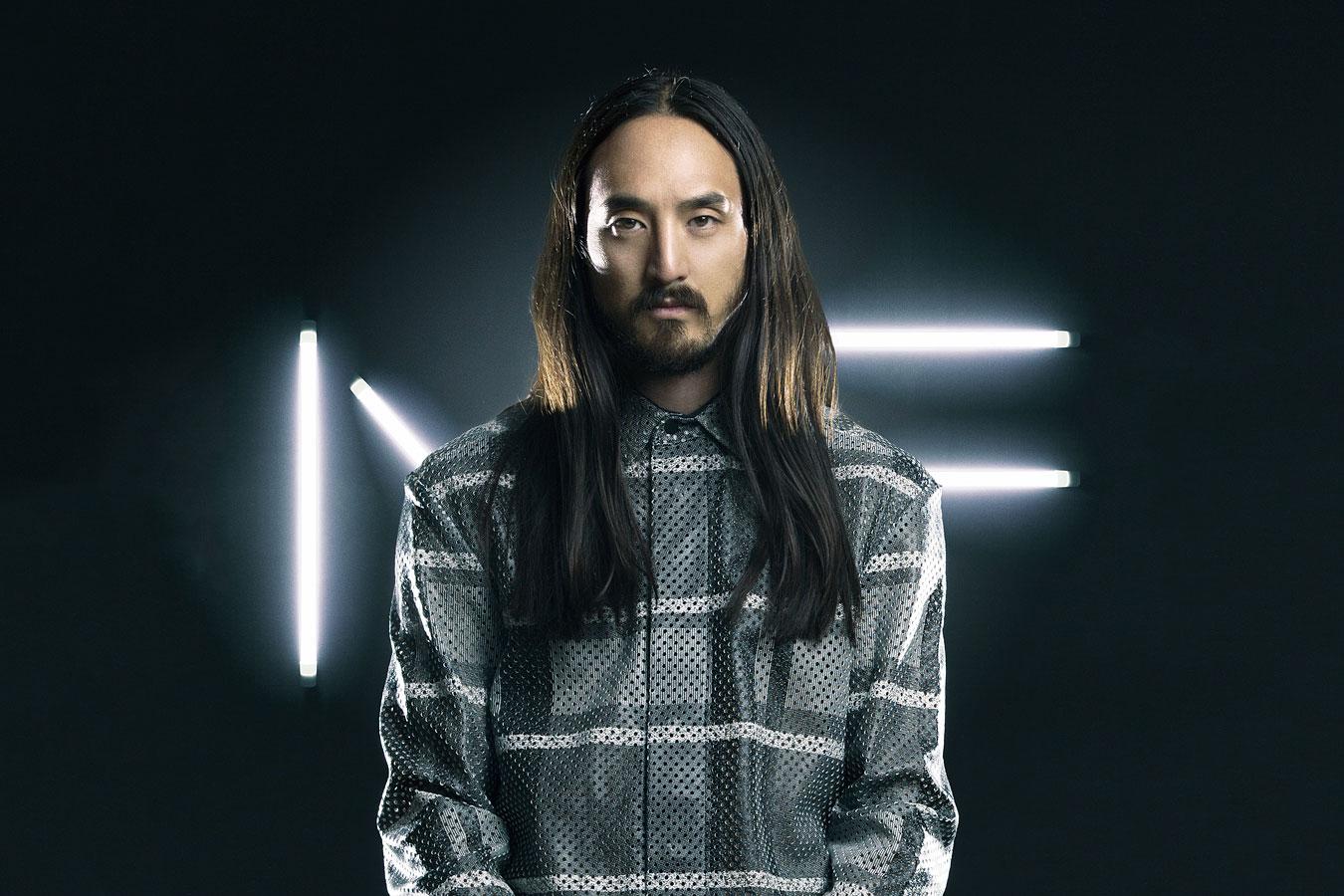
We haven’t posted this yet, but Aubrey de Gray is definitely one that needs to come out soon. His whole thing is, he’s a scientist who’s working with his team on how to reverse cellular degeneration. And if he can do it, then, basically, we’ll never actually age. And cancer would be a non-issue. I was asking some poignant questions: “Do you think it will happen in our lifetime, with the research you’ve been doing?”
I went to Oxford University and interviewed Richard Hawkins, author of The God Delusion. But I called him the wrong thing. I called him the contemporary Charles Darwin — and he’s the opposite. He’s like, “I can’t be contemporary. That means Charles Darwin would be alive.” (both laugh) I’m like, “Sorry, I said the wrong word.” He got pissed off. It was a bad way to start the interview. So I said let’s reset and start over.
Well, you just tell him, with cell regeneration, we could revive Charles Darwin and have him right here.
(laughs) I could have made them friends. I talked about the future with him. I’m a huge fan; I totally fanboyed out.
I also want to talk to Richard Branson about what he’s going to do with Virgin Galactic, and Elon Musk about SpaceX.
You have to do all that at 20,000 feet up in the air, though. Would you go to Mars?
Yeah. Actually, I’ve been talking to them, trying to set something up where they’d be having some sort of big concert up there. So I’ve been pitching myself in there: ”I want to go, I want to go.”
What’s the first song you would play on Mars?
I’d just write a song and produce it on the way there. The experience of what I’m seeing in front of me — that’s how I’d want to do it. Have a no-brainer attitude about it, and literally produce the exact sensory experience I’m having.
